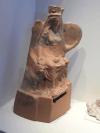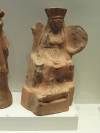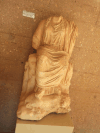
Metroon, Temple of Cybele, in Olympia, Greece (4th century BCE). (1.6M)
From the Cybele entry in Wikipedia:
Cybele is an Anatolian mother goddess; she may have a possible forerunner in the earliest neolithic at Çatalhöyük, where statues of plump women, sometimes sitting, have been found in excavations. Phrygia's only known goddess, she was probably its national deity. Greek colonists in Asia Minor adopted and adapted her Phrygian cult and spread it to mainland Greece and to the more distant western Greek colonies around the 6th century BCE.
In Greece, Cybele met with a mixed reception. She became partially assimilated to aspects of the Earth-goddess Gaia, of her possibly Minoan equivalent Rhea, and of the harvest–mother goddess Demeter. Some city-states, notably Athens, evoked her as a protector, but her most celebrated Greek rites and processions show her as an essentially foreign, exotic mystery-goddess who arrives in a lion-drawn chariot to the accompaniment of wild music, wine, and a disorderly, ecstatic following. Uniquely in Greek religion, she had a eunuch mendicant priesthood. Many of her Greek cults included rites to a divine Phrygian castrate shepherd-consort Attis, who was probably a Greek invention. In Greece, Cybele became associated with mountains, town and city walls, fertile nature, and wild animals, especially lions.
In Rome, Cybele became known as Magna Mater ("Great Mother"). The Roman state adopted and developed a particular form of her cult after the Sibylline oracle in 205 BCE recommended her conscription as a key religious ally in Rome's second war against Carthage (218 to 201 BCE). Roman mythographers reinvented her as a Trojan goddess, and thus an ancestral goddess of the Roman people by way of the Trojan prince Aeneas. As Rome eventually established hegemony over the Mediterranean world, Romanized forms of Cybele's cults spread throughout Rome's empire. Greek and Roman writers debated and disputed the meaning and morality of her cults and priesthoods, which remain controversial subjects in modern scholarship.
All pictures are © Dr. Günther Eichhorn, unless otherwise noted.
Anatolian mother goddess, partially assimilated to aspects of the Earth-goddess Gaia
Cybele's major mythographic narratives attach to her relationship with Attis, who is described by ancient Greek and Roman sources and cults as her youthful consort, and as a Phrygian deity. In Phrygia, "Attis" was not a deity, but both a commonplace and priestly name, found alike in casual graffiti, the dedications of personal monuments and several of Cybele's Phrygian shrines and monuments. His divinity may therefore have begun as a Greek invention based on what was known of Cybele's Phrygian cult. His earliest certain image as deity appears on a 4th-century BCE Greek stele from Piraeus, near Athens. It shows him as the Hellenized stereotype of a rustic, eastern barbarian; he sits at ease, sporting the Phrygian cap and shepherd's crook of his later Greek and Roman cults. Before him stands a Phrygian goddess (identified by the inscription as Agdistis) who carries a tympanon in her left hand. With her right, she hands him a jug, as if to welcome him into her cult with a share of her own libation. Later images of Attis show him as a shepherd, in similar relaxed attitudes, holding or playing the syrinx (panpipes). In Demosthenes' On the Crown (330 BCE), attes is "a ritual cry shouted by followers of mystic rites".
Attis seems to have accompanied the diffusion of Cybele's cult through Magna Graecia; there is evidence of their joint cult at the Greek colonies of Marseilles (Gaul) and Lokroi (southern Italy) from the 6th and 7th centuries BCE. After Alexander the Great's conquests, "wandering devotees of the goddess became an increasingly common presence in Greek literature and social life; depictions of Attis have been found at numerous Greek sites". When shown with Cybele, he is always the younger, lesser deity, or perhaps her priestly attendant. In the mid 2nd century, letters from the king of Pergamum to Cybele's shrine at Pessinos consistently address its chief priest as "Attis".
Rome characterized the Phrygians as barbaric, effeminate orientals, prone to excess. While some Roman sources explained Attis' death as punishment for his excess devotion to Magna Mater, others saw it as punishment for his lack of devotion, or outright disloyalty. Only one account of Attis and Cybele (related by Pausanias) omits any suggestion of a personal or sexual relationship between them; Attis achieves divinity through his support of Meter's cult, is killed by a boar sent by Zeus, who is envious of the cult's success, and is rewarded for his commitment with godhead.
The most complex, vividly detailed and lurid accounts of Magna Mater and Attis were produced as anti-pagan polemic in the late 4th century by the Christian apologist Arnobius, who presented their cults as a repulsive combination of blood-bath, incest and sexual orgy, derived from the myths of Agdistis. This has been presumed the most ancient, violent and authentically Phrygian version of myth and cult, closely following an otherwise lost orthodox, approved version preserved by the priest-kings at Pessinous and imported to Rome. Arnobius claimed several scholarly sources as his authority; but the oldest versions are also the most fragmentary and, during an interval of several centuries, apt to diverge into whatever version suited a new audience, or potentially, new acolytes. Greek versions of the myth recall those concerning the mortal Adonis and his divine lovers, - Aphrodite, who had some claim to cult as a 'Mother of all", or her rival for Adonis' love, Persephone - showing the grief and anger of a powerful goddess, mourning the helpless loss of her mortal beloved.
The emotionally charged literary version presented in Catullus 63 follows Attis' initially ecstatic self-castration into exhausted sleep, and a waking realization of all he has lost through his emotional slavery to a domineering and utterly self-centered goddess; it is narrated with a rising sense of isolation, oppression and despair, virtually an inversion of the liberation promised by Cybele's Anatolian cult. Contemporaneous with this, more or less, Dionysius of Halicarnassos pursues the idea that the "Phrygian degeneracy" of the Galli, personified in Attis, be removed from the Megalensia to reveal the dignified, "truly Roman" festival rites of the Magna Mater. Somewhat later, Vergil expresses the same deep tension and ambivalence regarding Rome's claimed Phrygian, Trojan ancestors, when he describes his hero Aeneas as a perfumed, effeminate Gallus, a half-man who would, however, "rid himself of the effeminacy of the Oriental in order to fulfill his destiny as the ancestor of Rome." This would entail him and his followers shedding their Phrygian language and culture to follow the virile example of the Latins. In Lucretius' description of the goddess and her acolytes in Rome, her priests provide an object lesson in the self-destruction wrought when passion and devotion exceed rational bounds; a warning, rather than an offer.
For Lucretius, Roman Magna Mater "symbolized the world order": her image held reverentially aloft in procession signifies the Earth, which "hangs in the air." She is the mother of all, ultimately the Mother of humankind, and the yoked lions that draw her chariot show an otherwise ferocious offspring's duty of obedience to the parent. She herself is uncreated, and thus essentially separate from and independent of her creations.
In the early Imperial era, the Roman poet Manilius inserts Cybele as the thirteenth deity of an otherwise symmetrical, classic Greco-Roman zodiac, in which each of twelve zodiacal houses (represented by particular constellations) is ruled by one of twelve deities, known in Greece as the Twelve Olympians and in Rome as the Di Consentes. Manilius has Cybele and Jupiter as co-rulers of Leo (the Lion), in astrological opposition to Juno, who rules Aquarius. Modern scholarship remarks that as Cybele's Leo rises above the horizon, Taurus (the Bull) sets; the lion thus dominates the bull. Some of the possible Greek models for Cybele's Megalensia festival include representations of lions attacking and dominating bulls. The festival date coincided, more or less, with events of the Roman agricultural calendar (around April 12) when farmers were advised to dig their vineyards, break up the soil, sow millet "and – curiously apposite, given the nature of the Mother's priests – castrate cattle and other animals."




This page contains 4 pictures
Here are the links to the other main pages on Greece:
Page last updated on Fri Aug 19 12:03:28 2022 (Mountain Standard Time)
Cybele on soaring.geichhorn.com